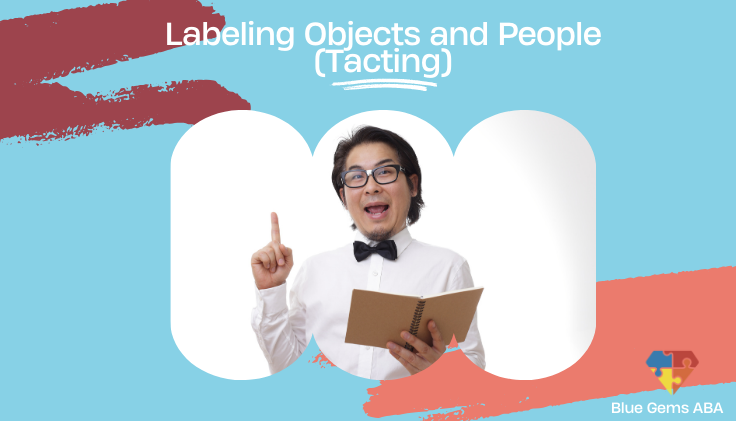Labeling Objects and People (Tacting)
Children with autism spectrum disorder (ASD) typically struggle with general communication, though how that challenge expresses itself is different with each child. For instance, some children may miss developmental milestones related to speaking, while others may not speak at all.
In addition, children with autism also commonly have problems with non-verbal communication, such as identifying and interpreting hand gestures, body language and tone of voice.
Applied behavior analysis, or ABA therapy, can help children on the autism spectrum improve their communication skills over time. By following the various strategies and using tools at their disposal, therapists work directly with children to customize a treatment plan that addresses their unique strengths and challenges.
Much of the work starts with the basics of communication, which for many children is labeling objects and people. Below, we’ll discuss how ABA therapy helps children with ASD label objects and people, and then expands communication to the next level with the skill of tacting.
Table Of Contents
How Does Labeling Work with ABA Therapy?
Labeling is often the first step of expressive communication for children. It involves identifying and then accurately naming objects, people or other things in their environment.
For instance, when children say “mama” or “dada,” they are labeling their mother or father. Labeling is a foundational skill for the development of vocabulary, helping children to build how they understand words by connecting words with actual objects in the real world.
In ABA therapy, teaching labeling involves three basic steps — recognizing an object, associating a word with that object, and then reinforcing and repeating those steps.
A therapist, for example, might show a patient a picture of a car on a flash card and then say the word “car.” The goal over time is to have the child recognize that the flash card is showing a car, then say the word “car” just like the therapist did.

They will use positive reinforcement to reward the child when they correctly label the object, such as giving them time to play with a toy or showing them extra praise.
How Does Tacting Work in ABA Therapy?
If labeling is the first step in expressive communication, then tacting is the next step. It involves a person commenting on things that they see in the environment.
Instead of just labeling a person or object like labeling does, tacting involves expressing an observation. Tacting is important because it helps children express what they are experiencing so that they can share that with other people.
In essence, tacting is taking labeling to the next level. Instead of just saying “car” when they see a picture of a car, the child will say “car drive” when they see a car driving on the road in real life.

In ABA therapy, teaching tacting to children also involves three basic steps — observing something in their environment, using descriptive language to express what they are observing, and interacting socially with someone else by sharing what they observe.
Tacting is a vital skill that helps children engage with other people and, as a result, build their social interactions. When children master tacting, they will learn how to express not just what they’re seeing, but what they are feeling and thinking, all of which builds a solid foundation for complex communication and interactions.
| Feature | Labeling | Tacting |
|---|---|---|
| Definition | Naming objects or people | Commenting on things in the environment |
| Purpose | Builds vocabulary and identification | Builds expressive language and social sharing |
| Example | Saying “car” when shown a car flash card | Saying “car driving” when seeing a car drive by |
| Teaching Strategy | Prompting with visual cues | Modeling and Natural Environment Teaching (NET) |
| Reinforcement | Positive reinforcement (praise/reward) | Reinforcement + social engagement |
How Does ABA Therapy Teach Labeling and Tacting?
ABA therapy will typically teach labeling and tacting in slightly different ways.
Most commonly, labeling is taught through prompting with visual cues, followed by reinforcement based on whether the child successfully labels or not.
This could include the therapist showing a flash card of the car, as described above. If the child correctly labels the car, they will receive their reward. If not, the therapist will correct the error and try again.
Tacting can be taught using some of the same strategies, with some adjustments. Modeling is a big part of teaching tacting, since it involves things that are happening in real-time in the child’s environment.
They might go outside, for example, and watch cars drive by. The therapist will then say “car driving” while pointing. When the next car goes by, they could point again and say “car driving” to get the child to engage as well.
Much of teaching this skill involves Natural Environment Teaching (NET) since the lessons are done in the child’s natural environment.
Blue Gems ABA Helps Children with ASD Build Communication Skills
Labeling and tacting are two of the essential building blocks of communication. That’s why they are such important aspects of ABA therapy for children with ASD.
At Blue Gems ABA, our team of experienced therapists teach labeling and tacting to patients to help them build their communication skills, which leads to improvements in many other aspects of life as well. All of our ABA therapy treatment plans are customized to each individual child’s unique strengths, challenges and preferences, which helps to make the therapy more effective.
To learn more, please contact us today.




